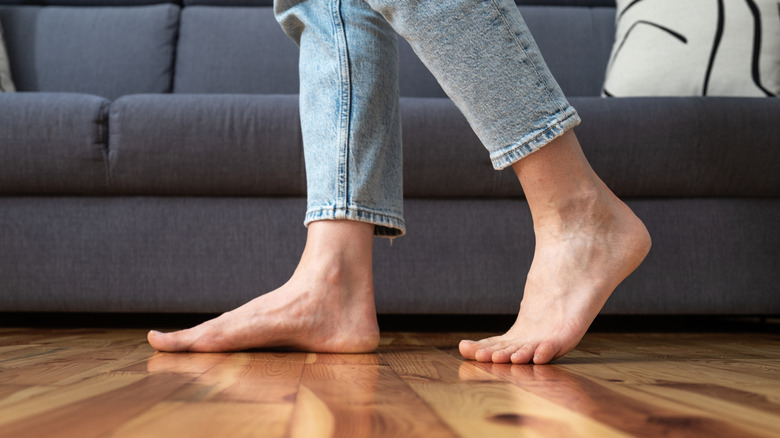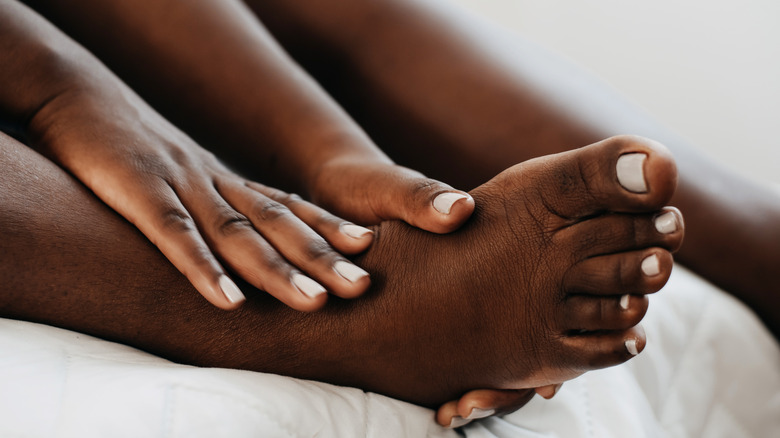The Unexpected Origins Behind The Big Toe
When it comes to the human body, much of it makes sense. For example, hands are necessary to grab and hold things; we wouldn't be able to walk without our feet; and the reason we have eyelashes and eyebrows is to protect our eyes from dust, particles, and various other debris. Then, of course, there are other parts of the human body that leave one wondering. After all, one would think wisdom teeth and the coccyx would have evolved out of existence by now.
That said, the big toe is a part of the body that actually serves a purpose. If you were to stand up right now and take a step, that big toe is everything. If you try to walk with your big toe in the air, only using the other four toes to propel you forward, you'll find things get a little shaky. Because of this, it's easy to deduce that the big toe is a must, as far as parts of the body are concerned.
However, according to a 2018 study published in the Proceedings of the National Academy of Sciences, the big toe wasn't just late in its development into the form we have today, compared to other foot bones, but it also may have been the very last toe to develop. Considering how essential it is to walking and running, this has scientists re-evaluating what they once knew about foot bones.
Why the origins of the big toe are important
For the researchers, discovering that the big toe may have developed last is interesting news because it creates a clearer timeline of things that can sometimes only be hypothesized. According to the Smithsonian National Museum of Natural History, human beings have been walking on two feet for roughly 6 million years. So, if the big toe was indeed the last of the toes to form, it suggests that even when humans first reached the ability to be bipedal (move on two feet), they probably didn't walk the way we do today. In fact, it would be impossible, suggesting that different species were walking on two feet in their own ways. It also points to the possibility that how our ancestors used their feet, especially when they were still in the trees, wasn't exactly what was originally thought.
"It was a bit of shock when hominins were found that have a grasping, or opposable, big toe, as this was thought to be incompatible with effective bipedalism," an expert in human anatomy at the Natural History Museum in London, Professor Fred Spoor, told the BBC. "This work shows that different parts of the foot can have different functions. When a big toe is opposable, you can still function properly as a biped." In other words, maybe human beings millions of years ago really had it all, relatively speaking, of course.
Why human beings became bipedal
Because swinging from the trees, similar to primates, sounds like far more fun and also enabled humans to use their feet just as well as their hands for grasping, it does make one wonder why humans became bipedal. Of course, in regards to moving great lengths, travel became easier when humans were upright, but the exact reason has yet to be unearthed.
"To date, the numerous hypotheses for the evolution of bipedalism share the idea that hominins (human ancestors) came down from the trees and walked upright on the ground, especially in more arid, open habitats that lacked tree cover," anthropologist Dr. Fiona Stewart told UCL News. Others have hypothesized that once humans were able to stand up right, they could use their hands and arms more for carrying things, and became more energy efficient — aspects that could have contributed to the evolution of a bigger brain.
Ultimately, how we got here as modern-day humans — big toes, upright gait, and all — was not something that happened overnight. It took millions and millions of years. But knowing the unexpected origins of the big toe can help scientists better decipher how we arrived at this point, so as to better understand where human beings may be headed. And considering our society's deep affinity for technology, including a tendency toward "tech neck," that's going to be a really interesting evolution to predict and, ideally, witness.


